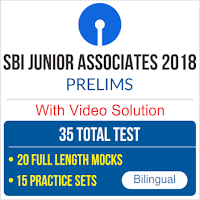Dear Aspirants,
Reasoning Ability is an onerous section. With the increasing complexity of questions, it becomes hard for one to give it the cold shoulder. Today is the Day 51 of the 60 Days SBI Clerk Prelims Study Plan. The only way to make the grade in this particular section in the forthcoming banking exams is to practice continuously with all your heart and soul. And, to let you practice with the best of the latest pattern questions, here is the Adda247 Reasoning Quiz based on the study plan and the exact same pattern of questions that are being asked in the exams.
Check Detailed VIDEO SOLUTION for this Quiz
Direction (1-5): Read the information carefully and answer the questions:
Eight persons- P, Q, R, S, T, U, V and W are sitting around a circle. Three of them are facing toward the centre and other five are facing outside the centre of the circle. Two persons sit between W and T and two persons sit between U and T. R sits second left to V, who faces the centre of the circle. Q faces the centre of the circle. Q sits third right to U. S is not neighbour of W. R is sitting third to the left of S, who sits second right to P, who faces outside the centre of the circle. T is not opposite to U and R. Immediate neighbors of U faces opposite direction.
Q1. Who among following sits fourth to right of P?
(a) U
(b) S
(c) T
(d) R
(e) W
Q2. Who is sitting third to the left of T?
(a) S
(b) U
(c) Q
(d) W
(e) None of these
Q3. Who among following sits immediate left of U?
(a) R
(b) P
(c) T
(d) S
(e) W
Q4. Who is second to the right of V?
(a) U
(b) W
(c) Q
(d) S
(e) P
Q5. How many people are sitting between W and S, when counted in clockwise direction from S?
(a) Three
(b) Four
(c) One
(d) Two
(e) None of these
Directions (6-10): Study the following information and answer the questions.
Eight friends L, M, N, O, A, B, C and D are seated in a straight line, but not necessarily in the same order. Some of them are facing north and some are facing south. A is an immediate neighbour of one who is sitting at an extreme end of the line. Only three people sit between A and C. O sits second to the right of C. O does not sit at an extreme end of the line. D sits on the immediate left of L. D is not an immediate neighbour of C. The immediate neighbours of L face opposite direction. The persons who are sitting at the extreme ends face opposite directions. M sits second to the left of B. B faces north. B is not an immediate neighbour of A. The immediate neighbours of B face same direction. Both A and M face a direction opposite to that of O.
Q6. As per the given arrangements, which of the following statements is not true with respect to L . ?
(a) L faces south.
(b) L is fourth to the right of M.
(c) L is 2nd to left of A.
(d) L is between C and D.
(e) None of these
Q7. How many persons sit on the left of M?
(a) One
(b) Two
(c) Three
(d) Four
(e) None of these
Q8. What is the position of O with respect to L?
(a) Immediate left
(b) Third to left
(c) Third to right
(d) Fourth to left
(e) None of these
Q9. Who among the following are immediate neighbours of M?
(a) A, O
(b) A, B
(c) C, B
(d) N, O
(e) None of these
Q10. Four of the given five are alike in a certain way based on the given arrangement and hence form a group. Who among the following does not belong to that group?
(a) N
(b) O
(c) L
(d) B
(e)C
Directions (11-15): In these questions, a relationship between different elements is shown in the statements. The statements are followed by two conclusions. Give answer
Q11. Statement: P<Q; G<D≤E; G≥F>Q
Conclusion: I. G≥Q II. E>G
(a) if only conclusion II is true.
(b) if only conclusion I is true.
(c) if neither conclusion I nor II is true.
(d) if either conclusion I or II is true.
(e) if both conclusions I and II are true.
Q12. Statement: M>S≥K; A>S=H; M>T
Conclusion: I. A>K II. K<T
(a) if both conclusion I and II are true.
(b) if only conclusion I is true.
(c) if neither conclusion I nor II is true.
(d) if either conclusion I or II is true.
(e) if only conclusion II is true.
Q13. Statement: A≥K; Q<O<M≥N; K≥O=T
Conclusion: I. K≥Q II. A>T
(a) if only conclusion II is true.
(b) if either conclusion I or II is true.
(c) if neither conclusion I nor II is true.
(d) if only conclusion I is true.
(e) if both conclusions I and II are true.
Q14. Statement: J> T≤N; A>T>R; N<M
Conclusion: I. M< J II. J≤M
(a) if only conclusion II is true.
(b) if only conclusion I is true.
(c) if neither conclusion I nor II is true.
(d) if either conclusion I or II is true.
(e) if both conclusions I and II are true.
Q15. Statement: D>B≥C; F<M≤T<D; B>Q; T=E
Conclusion: I. Q<D II. E>C
(a) if only conclusion II is true.
(b) if either conclusion I or II is true.
(c) if neither conclusion I nor II is true.
(d) if only conclusion I is true.
(e) if both conclusions I and II are true.






 GA Capsule for SBI Clerk Mains 2025, Dow...
GA Capsule for SBI Clerk Mains 2025, Dow...
 The Hindu Review October 2022: Download ...
The Hindu Review October 2022: Download ...
 Rajasthan Gramin Bank Formed after Merge...
Rajasthan Gramin Bank Formed after Merge...





